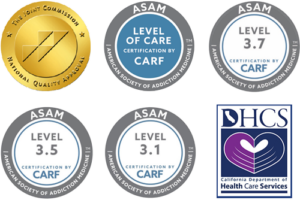How Long Does Delirium Tremens Last? Timeline, Symptoms, Treatment & Recovery
Published on: November 20, 2025
Delirium tremens (DTs) is one of the most dangerous complications of alcohol withdrawal. It can feel frightening—for the person experiencing it and the people who love them. But with the right medical care, DTs is treatable, and recovery is absolutely possible.
At Journey Hillside Tarzana, our clinical team helps individuals safely navigate withdrawal through compassionate, medically supervised detox. For anyone concerned about severe withdrawal, our alcohol addiction treatment program provides the structure, monitoring, and therapeutic support needed to stay safe.
Below is a clear, empathetic guide to how long DTs lasts, what symptoms look like, who is at risk, and how medical treatment supports recovery.
What Is Delirium Tremens?
Delirium tremens is the most severe form of alcohol withdrawal—marked by dangerous changes in the nervous system, body temperature, heart rate, and cognitive functioning.
When someone who is physically dependent on alcohol suddenly stops drinking, the brain loses the “slowing” effects alcohol once provided. In response, the nervous system becomes overactive, leading to extreme agitation, confusion, hallucinations, seizures, and inflammatory responses.
DTs is a medical emergency , but one that responds well to timely treatment. Early identification and stabilization significantly reduce complications, long-term cognitive effects, and mortality.
Who Is at Highest Risk?
Anyone with long-term or heavy alcohol use can develop severe withdrawal, but certain groups face especially high risk:
- People who have experienced withdrawal seizures or severe withdrawal before
- Older adults
- Individuals with liver disease, chronic medical conditions, or malnutrition
- People who drink heavily every day
- Individuals who stop drinking abruptly after prolonged use
- Those who lack stable medical care or support
It is also possible—though less common—for vulnerable individuals to develop DTs after only several days of intense drinking. Understanding personal risk makes it easier to choose the safest environment for detox.
Timeline of Delirium Tremens
Everyone’s body responds differently, but most clinical cases follow a recognizable timeline:
6–24 Hours After Last Drink: Early Withdrawal Begins
Symptoms may include anxiety, tremors, nausea, sweating, headaches, and difficulty sleeping. These discomforts are early signals that the nervous system is destabilizing.
24–48 Hours: Seizure Risk Increases
Generalized tonic-clonic seizures most often appear within this timeframe. They may occur before full DTs develops.
If you or someone you love is preparing to stop drinking, learning how to detox from alcohol safely is essential to prevent these complications.
48–72 Hours: Peak of Delirium Tremens
This is the most dangerous period. Symptoms can include:
- Hallucinations (visual, tactile, or auditory)
- Severe confusion or inability to orient
- Fever, sweating, high heart rate, elevated blood pressure
- Agitation, intense fear, or paranoia
3–7 Days: Medically Treated DTs Begin to Resolve
With proper medication and hydration, confusion and autonomic instability gradually improve. Supportive care and rest become primary needs.
1–2 Weeks (Rare Cases): Prolonged Symptoms
Delayed treatment, severe medical conditions, or complications such as Wernicke encephalopathy can extend recovery time.
Symptoms & Clinical Features of Delirium Tremens
DTs affects both the body and the mind. Common symptoms include:
- Severe autonomic hyperactivity (fever, tachycardia, hypertension)
- Extreme confusion, disorientation, or inability to focus
- Hallucinations
- Tremors, agitation, or restlessness
- Seizures
- Dehydration, electrolyte imbalance, and disrupted sleep
These symptoms can intensify quickly. Medical monitoring ensures that changes are recognized and treated before becoming life-threatening.
For those concerned about the more serious complications of withdrawal, our resource on whether alcohol withdrawal can be fatal outlines when symptoms require urgent care.
Assessment & Monitoring
When a patient arrives for care, the first priority is stabilization. Clinicians will:
- Assess alcohol use history and prior withdrawals
- Evaluate vital signs and neurological function
- Order labs: electrolytes, liver function tests, glucose, CBC, magnesium, phosphate
- Use withdrawal rating scales like CIWA-Ar to guide medication
- Begin continuous cardiorespiratory monitoring
Because symptoms can shift rapidly, frequent reassessments help the medical team adjust treatment in real time.
Evidence-Based Treatment for Delirium Tremens
Benzodiazepines: First-Line Care
These medications restore inhibitory balance in the brain and reduce agitation, seizures, and autonomic overactivity. Lorazepam, diazepam, and chlordiazepoxide are commonly used.
Symptom-Triggered vs. Scheduled Dosing
CIWA-Ar-guided dosing helps target medication to real-time symptoms. In some cases, scheduled dosing is safer.
Adjunctive Agents
- Phenobarbital for refractory cases
- Propofol in ICU-level care when deep sedation is required
- Supportive agents like gabapentin only as adjuncts—not replacements for benzodiazepines
Supportive Care
- IV fluids and electrolyte correction
- Early administration of parenteral thiamine
- Nutritional support, treatment of infections, wound care if present
When ICU Care Is Necessary
A person experiencing DTs may need ICU admission if they have:
- Respiratory compromise
- Repeated or uncontrolled seizures
- Unstable vital signs
- Severe agitation requiring continuous sedative infusions
- Risk of airway obstruction
- Multi-organ complications
Others with moderate but stable symptoms may be safely treated in a well-staffed medical detox setting.
Special Considerations for Older Adults & Liver Disease
Older adults and people with impaired liver function may be more sensitive to medications. Clinicians often choose benzodiazepines like lorazepam or oxazepam that are safer in liver impairment. Slow titration, close monitoring, and gentle supportive care help prevent complications.
When Standard Treatment Isn’t Enough
Refractory DTs require escalation. Phenobarbital becomes an important tool because it increases GABA activity and provides anticonvulsant protection. These cases generally require intensive monitoring to protect breathing, heart function, and safety.
Conditions That Mimic DTs
Some medical conditions can resemble DTs, including:
- Sepsis or infection
- Metabolic imbalances
- Hypoglycemia
- Stroke
- Sedative withdrawal
- Anticholinergic toxicity
- Stimulant intoxication
A correct diagnosis is crucial to ensure effective, safe treatment.
Prevention & Safer Detox Options
DTs cannot always be prevented, but identifying risk and choosing the right detox environment significantly lowers the odds.
People at low risk may detox safely in outpatient settings with clinical oversight.
Those at moderate to high risk —especially individuals with any prior withdrawal complications—are safest in medically supervised detox.
If you’re unsure where you fall on that spectrum, our guide to 7 Signs You May Need Detox can help you understand the early warning signs.
Recovery & Returning to Daily Life
Most people begin regaining physical stability within days to a week, though cognitive clarity may take longer—especially if complications occurred. For safety-sensitive activities like driving or work, clearance from a clinician and several days without sedative effects are essential.
Holistic recovery continues well beyond detox. At Journey Hillside Tarzana, clients transition into a structured therapeutic program that supports emotional healing, relapse prevention, and long-term stability.
Long-Term Outcomes & the Importance of Thiamine
Thiamine supplementation dramatically lowers the risk of Wernicke encephalopathy and Wernicke–Korsakoff syndrome—two causes of irreversible cognitive decline. Early thiamine administration is standard because it prevents major neurologic complications, even if research on subtle long-term cognitive outcomes is still developing.
Delirium Tremens FAQ
Can DTs happen after only a few days of drinking?
Yes. While long-term heavy drinking increases risk, some vulnerable individuals can develop severe withdrawal after shorter periods of intensive use.
Is ICU care always required?
No. ICU care is needed only when symptoms threaten breathing, heart stability, or require deep sedation. Many cases are safely managed in medical detox units.
Are benzodiazepines safe for older adults?
Yes, when used carefully. Clinicians choose safer agents and monitor closely to avoid oversedation.
Can other conditions mimic DTs?
Absolutely. Infections, metabolic problems, and other substance withdrawals can look similar, making medical evaluation essential.
How soon can someone return to work or driving after having DT?
Only once fully oriented, medically stable, and free of sedative effects for 24–48 hours—longer for complicated cases.
Does thiamine prevent long-term cognitive problems associated with DT?
It prevents the most dangerous neurologic complications and is considered essential early in withdrawal care.
A Safe Path Forward
Delirium tremens is serious, but you don’t have to navigate it alone. With compassionate medical supervision, recovery is not just possible—it’s expected.
If you or a loved one is concerned about severe withdrawal or detox safety, our team offers confidential assessments and individualized care plans.
Start by verifying your insurance so we can guide you toward safe and supportive treatment options.



